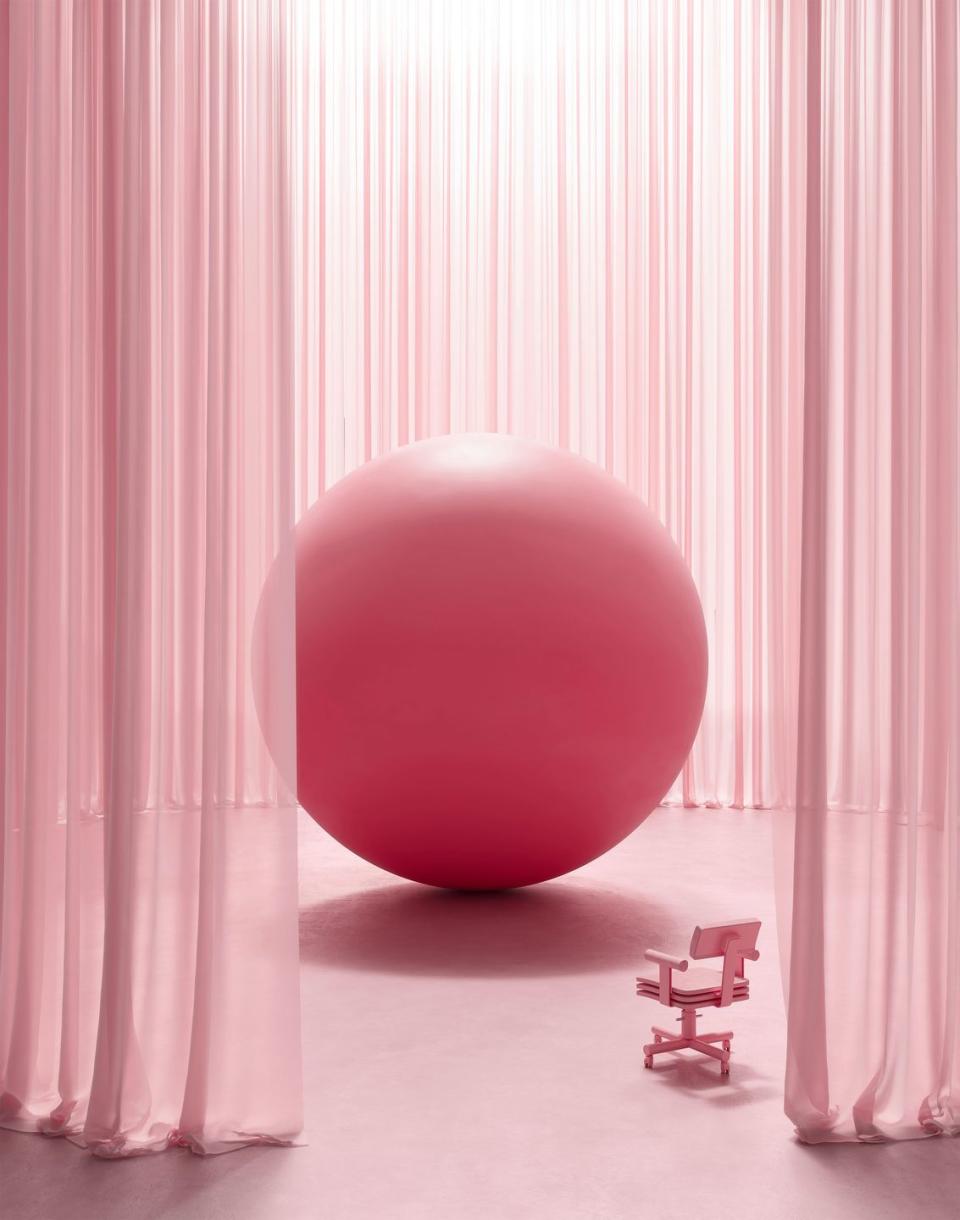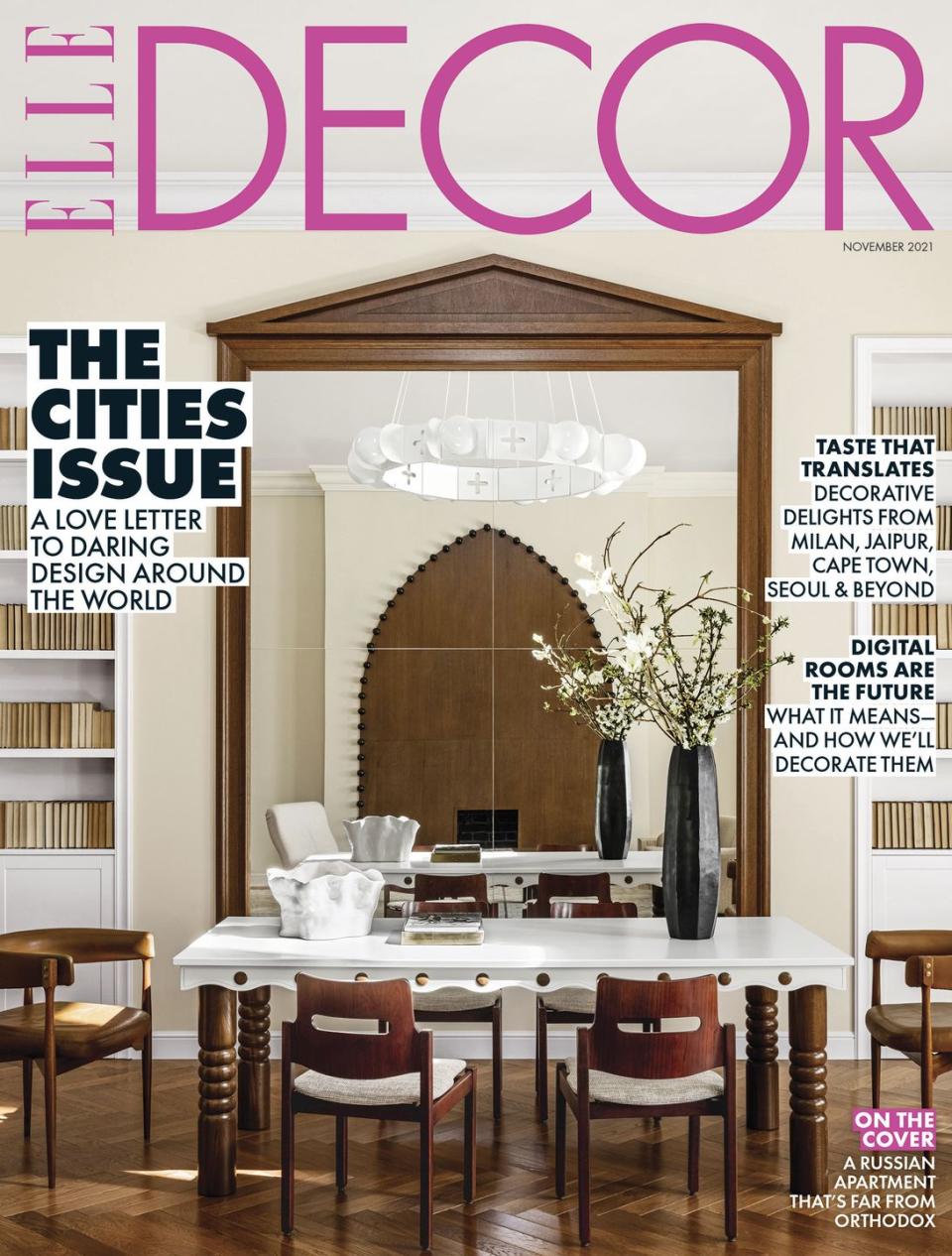What Happens When an NFT Furniture Darling Goes IRL? Design Magic.

Above: Graphic designer Andrés Reisinger’s rendering of his Bold chair, presented on dreamy, isolated terrain.
As a child growing up in Buenos Aires in the 1990s, the graphic designer Andrés Reisinger was obsessed with video games. But instead of playing them, he wanted to create the worlds in which they took place. Now based in Barcelona, he’s become an Instagram sensation designing dreamscapes: hushed, surreal spaces where it’s always magic hour and nothing is ever out of place. These visually soothing, digitally rendered fantasies are both hyperreal and unreal—uncanny valleys for ELLE DECOR readers. Beyond their pastel perfection, they have a slightly jarring tranquillity that matches the moment: At a time when so many apartments have been left deserted, Reisinger’s are populated not by people but by meticulously imagined furniture.
Reisinger has been creating ethereal spaces, as rendered on social media and in ads for companies like Microsoft and Cassina, for several years. But they’re tailor-made for the pandemic, and Reisinger’s popularity exploded last spring, when NFTs—non-fungible tokens, or unique, collectible digital versions—of his digital furniture were auctioned for $450,000. In a year without touch, they underlined the literal value of the intangible.
After the soothing emptiness of his digi-worlds, which felt like spaces to hold our grief, the process of molding real furniture out of leather, fabric, and steel was lively—and messy. “When I started, I didn’t know how to nail two pieces of wood together,” Reisinger says. But after a year of trial and error, collaborating with artisans in both Buenos Aires and Milan, his chubby, Instagram-famous Hortensia chair for the Dutch design brand Moooi was finally made flesh, in molded foam dressed in thousands upon thousands of laser-cut pink petals.
Furniture that was glimmering and eerie in renderings becomes playful but complicated in reality, eliciting emotions in shorthand. Reisinger feeds midcentury modern icons through a millennial-pink processor and refracts them through a cute neotenic lens, like design Baby Yodas. His soft, billowy Hortensia is one part ASMR, five parts Pierre Paulin. His TimeTable, a flat plane cantilevered over a large gumball, could be Memphis Milano for the Wing. Tangled, an ergonomic yellow noodle of a chair, pays homage to Terje Ekstrøm. Like Andy Warhol, Reisinger toys with pop culture and nostalgia; with light and space, like James Turrell; with color, like Luis Barragán; with the impossible architecture of dreams, like Giorgio de Chirico. The allusions are seemingly endless but also visually spare, like a well-curated Instagram grid.

The bridge between the digital and the physical, the imagined and the real, the perfectly composed and the imperfectly complicated, excites Reisinger. When, after working with 3D software for over a decade, he reached its limits, he realized the challenge was to “stop imagining and start building.”
For him, dreamscapes and impossible objects aren’t just a fad: they’re a necessity. “We create the world we want to live in,” he says. “Sometimes you first need to push beyond the bounds of the physical to get there.”
In addition to the Hortensia, five of Reisinger’s NFTs were given limited-edition physical counterparts, including Matsumoto, a Pepto-Bismol-colored plywood bench, and Abba, a pink office chair with a three-tiered seat. In September, Reisinger launched three new pieces at Salone in Milan in partnership with Nilufar Gallery: the Complicated sofa, a Mylar intestine that must be constantly rearranged; the enormous Bold chair, which, by its size, encourages its sitter to take up literal and metaphorical space; and the Crowded Elevator, a steel deck chair overflowing with a bubblegum-soft cushion that straddles the line between comfort and suffocation.
There’s a glossy superficiality to Reisinger’s digital work that speaks to the surface way we engage with so much content online. But his physical designs, surreal and a little off, alchemize their referents to hint at our own absence in a world we inhabit more and more virtually. It’s a trend Reisinger wants to counter: “I’m interested in the space where the digital and the real worlds meet,” he says. “But I’m not trying to make a chair that is beautiful or will fit into your color scheme. Comfort isn’t the goal. I want people to react to the objects in their environment, be challenged, change their behavior.”
Like many this year, Reisinger sought to reimagine the outside world to better suit the future. He compares his furniture, extracted from the digital realm and placed in physical space, to the rocks astronauts brought back from the moon. It lives in a DMZ between what is and what could be. “His genius lies in [mining] the dream world,” Nilufar’s Nina Yashar says. As the pandemic ebbs and we reemerge burdened with an expectation of renewal yet desperate for rejuvenation, Reisinger’s designs remind us that we too might make real some of the dreams we had while we were locked away.
Gabriella Fuller is a writer based in New York City and the cofounder of Vivamus, a midcentury furniture gallery.

This story originally appeared in the November 2021 issue of ELLE DECOR. SUBSCRIBE
You Might Also Like

